Entertainment and the Anti-Ukrainian Bubble: What YouTube Recommends in Poland
The risk of encountering disinformation on YouTube in Poland is lower than in Ukraine. The primary shield against disinformation and Russian-language content for Poles is their lack of proficiency in Russian.
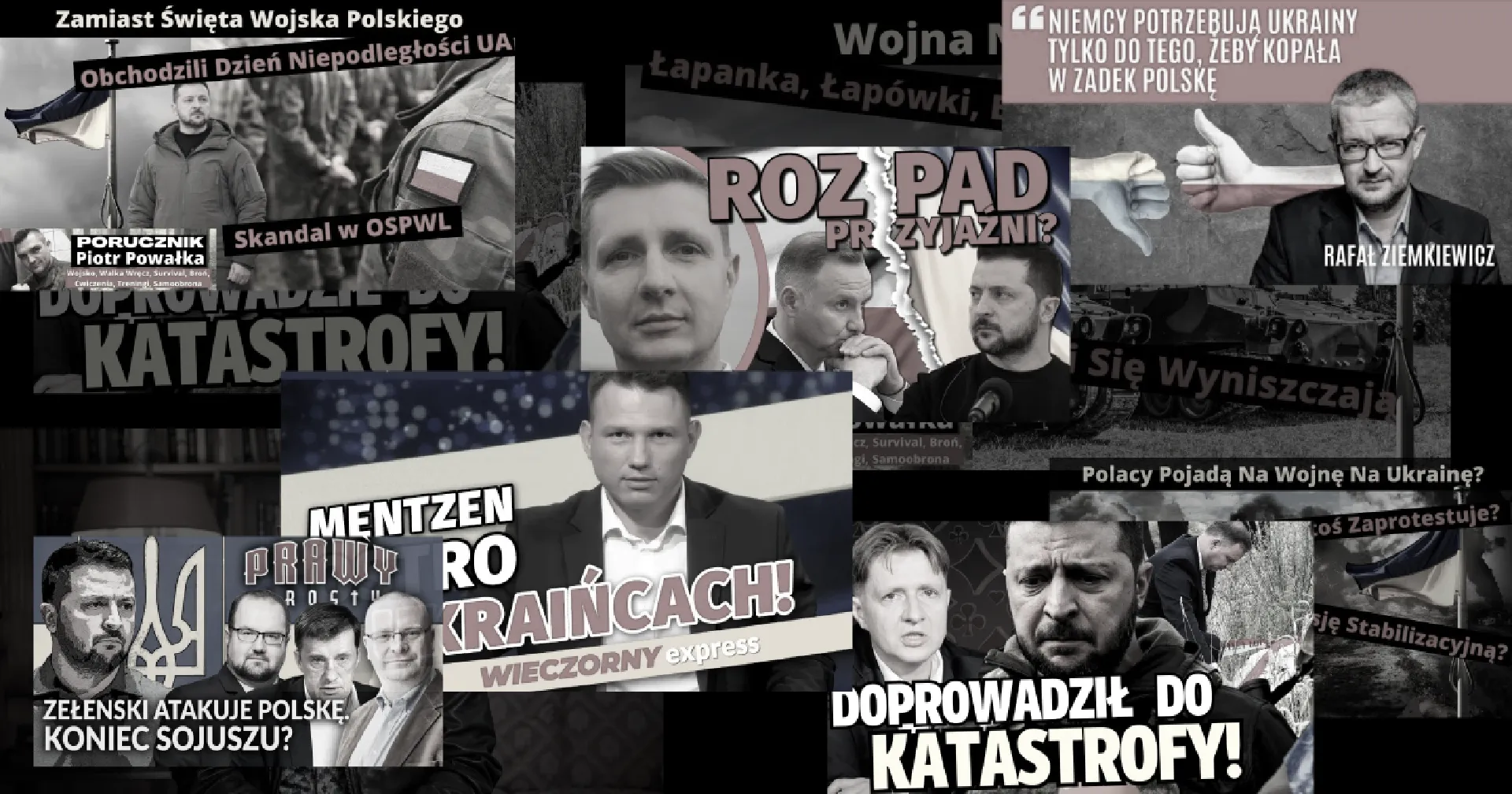
Entertainment and the Anti-Ukrainian Bubble:
What YouTube Recommends in Poland
Читати українською / Czytaj po polsku.
The risk of encountering disinformation on YouTube in Poland is lower than in Ukraine. The primary shield against disinformation and Russian-language content for Poles is their lack of proficiency in Russian.
Additionally, the information landscape in Poland is safeguarded against disinformation by EU laws and the specific behaviors and preferences of the users themselves, who tend to view news on YouTube significantly less than Ukrainians. However, there still remain gray areas and vulnerabilities within the platform itself, which we have explored by asking over 100 Polish volunteers to install our application and collect all the recommendations provided by YouTube over two months.
Our study revealed two main findings:
- In Poland, people turn to YouTube for entertainment, not for political news or political bloggers.
- If a user watches videos with anti-Ukrainian and pro-Russian narratives, the recommendation algorithms generously offer many new videos with similar narratives.
Read the first part of the study, "The Piggyback Trick How YouTube Algorithms Promote Conspirology and Propaganda" here.
YouTube is one of the most popular social networks in Poland. As of 2023, it boasts 27.5 million Polish users, meaning two out of three Poles visit YouTube to watch videos or listen to music.
Consequently, all of these users are at risk of encountering conspiracy theories or, for instance, anti-Ukrainian manipulations through the platform's recommendation algorithms. We already know that YouTube's recommendation algorithms are not perfect and often aid in promoting Russian disinformation and conspiracy theories. But is the situation identical across the Ukrainian-Polish border? Or do slightly different rules apply for EU member countries?
We set out to investigate and asked over 100 Polish volunteers to install an application that, over the course of two months, collected all the recommendations provided by YouTube during desktop video viewing.
The study involved 122 Poles who watched YouTube videos on desktops several times a week. The research period spanned from the end of July to early October 2023.
Participants were recruited by the research agency MASMI Poland based on screening survey results. Only adult respondents who watched video content on YouTube in Polish using desktop (Google Chrome browser) several times a week were invited to participate.
Participants installed an application developed by Texty.org.ua, which recorded data about the viewed video content and the recommendations provided by the platform.
In total, during the research period, we received information about nearly 300,000 viewed videos and 420,000 recommendations that YouTube suggested for these videos.
YouTube is a Platform for Entertainment, Not Politics
One of the most significant findings of our study is that in Poland, YouTube is used less frequently than in Ukraine for news consumption. Polish audiences primarily turn to online media, television, or streaming platforms for news and political talk shows. This is because many such programs in Poland are only accessible through subscriptions or on websites with their own video players.
For instance, Polsat News, a news channel that is part of the extensive digital multi-channel television network Polsat Network, has a virtually inactive YouTube channel with 117,000 subscribers, with the last update being three months ago. Despite this, Polsat News offers access to its video content not only to subscribers and digital TV viewers but also to website visitors. Ukrainian news outlets might consider this a missed opportunity to engage with an already established audience. However, this channel is not alone in prioritizing copyright concerns over YouTube presence.
Another example is the news channel TVN24, part of the TVN Network. It is available on various digital platforms and cable television. Access to its content requires a subscription, and unlike YouTube, it links to Facebook on its website. The official YouTube channel for TVN24 only hosts about 90 videos.
This isn't to say that Polish news is entirely absent from YouTube. TVP Info, the news channel of the public broadcaster TVP, has 340,000 subscribers and publishes over a dozen videos daily. However, this doesn't fully represent the news space on YouTube in Poland, as audience demand plays a significant role.
A comparison of the videos watched by participants in our study in Ukraine and Poland reveals a distinct difference. While in Ukraine, the "News & Politics" category ranked second in popularity among participants, in Poland, it fell far behind other entertainment categories.
Most Viewed Video Categories Among Research Participants
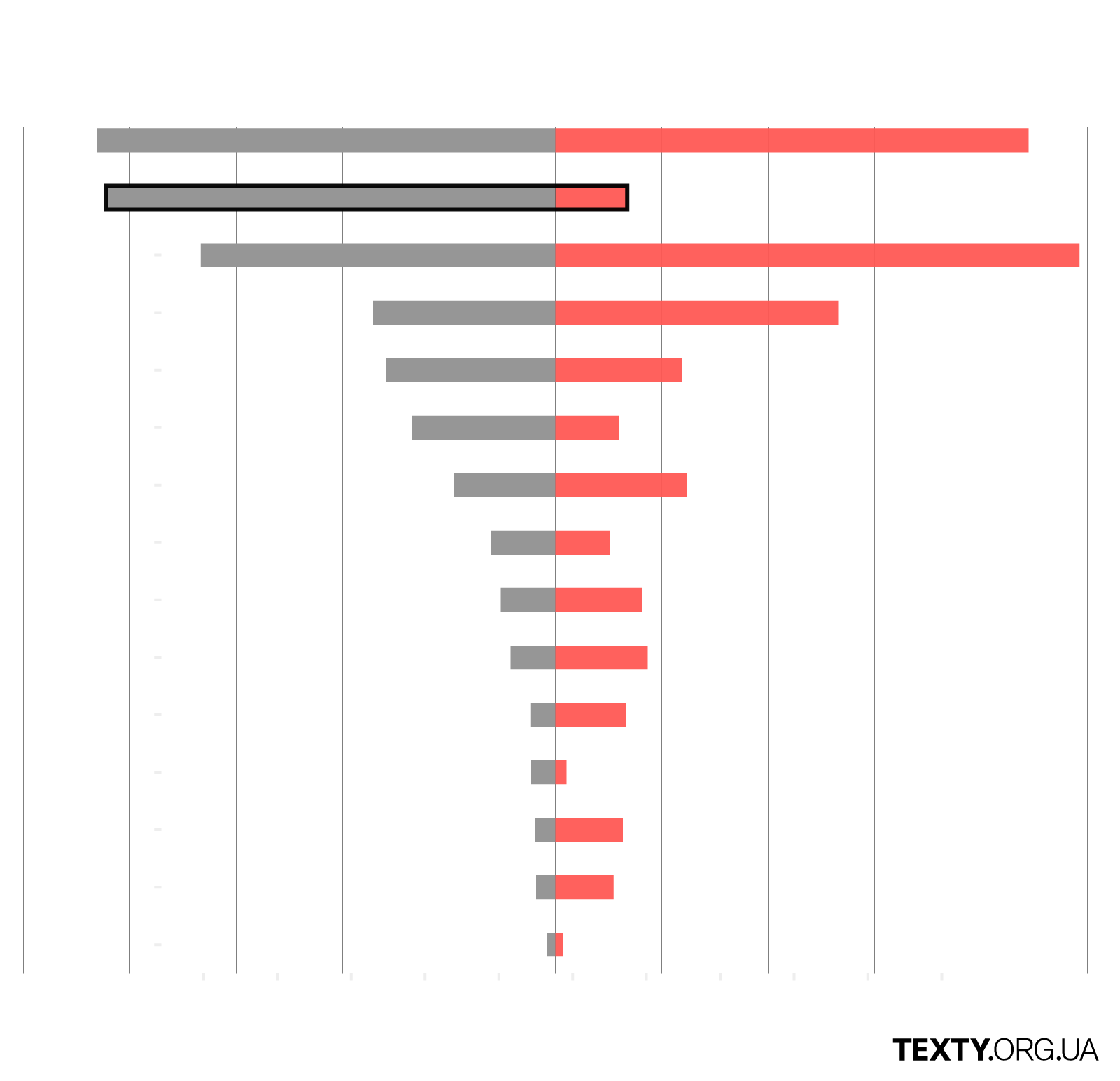
% of total views
UA
PL
People & Blogs
News & Politics
Music
Entertainment
Games
Film & Animation
Education
Comedy
Howto & Style
Science & Technology
Sports
Nonprofits & Activism
Autos & Vehicles
Travel & Events
Pets & Animals
25
20
15
10
5
0
5
10
15
20
25
Data from a custom-built application
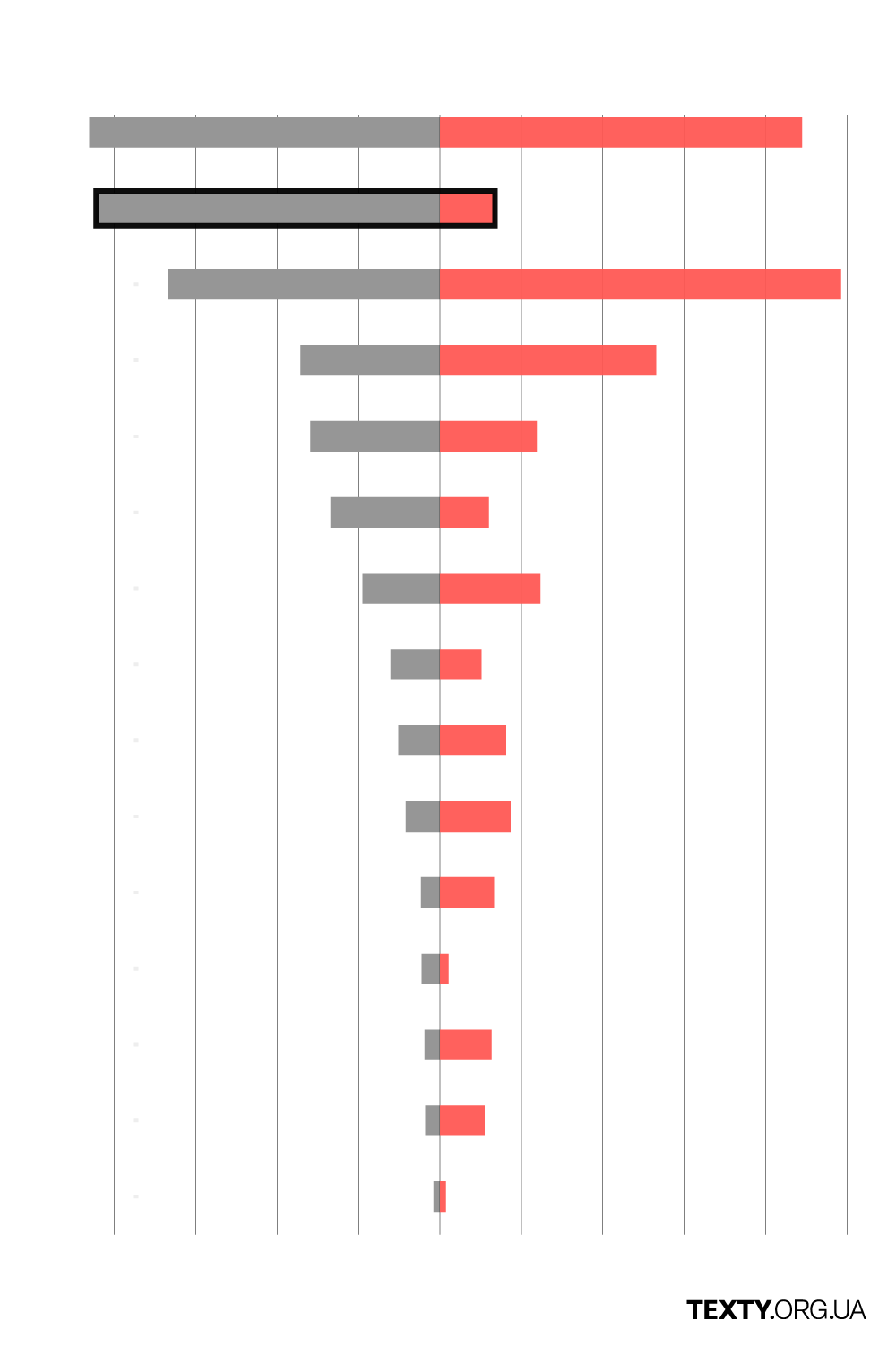
% of total views
People & Blogs
UA
PL
News & Politics
Music
Entertainment
Games
Film & Animation
Education
Comedy
Howto & Style
Science & Technology
Sports
Nonprofits & Activism
Autos & Vehicles
Travel & Events
Pets & Animals
20
15
10
5
0
5
10
15
20
25
Data from a custom-built application
Our participant sample is not representative of the entire population, but the apolitical nature of Polish preferences on YouTube is quite noticeable, even within the top 50 most popular Polish YouTube channels.
None of the 50 largest Polish YouTube channels in December, in terms of subscriber count (according to hypeauditor.com), operate in the “News and Politics” category. For context, in Ukraine, 12 of the top 50 channels on YouTube are television channels, with one (Channel 24) ranking third.
However, a closer look at the most popular Polish channels reveals a significant vulnerability and a hidden avenue for YouTube manipulations, including anti-Ukrainian narratives. This is where bloggers come into play. Their influence and reach in the digital space make them potential conduits for disseminating various narratives, including those that might be politically slanted or manipulative, despite the generally apolitical nature of popular Polish YouTube content.
The Gray Zone: Polish Bloggers Against Ukraine and Ukrainians
In the realm of the most commented-on YouTube channels in Poland, "Dziki Trener" ("Wild Coach") ranks third. Initially, his videos closely aligned with the channel's title. However, today, the blogger uses his platform to express emotional stances on current socio-political issues - ranging from the values of modern youth to the (un)gratefulness of Ukrainian refugees. He's known for his far-right views and, since the beginning of the full-scale invasion, for spreading hostility against Ukrainians under the guise of concern for Poles.
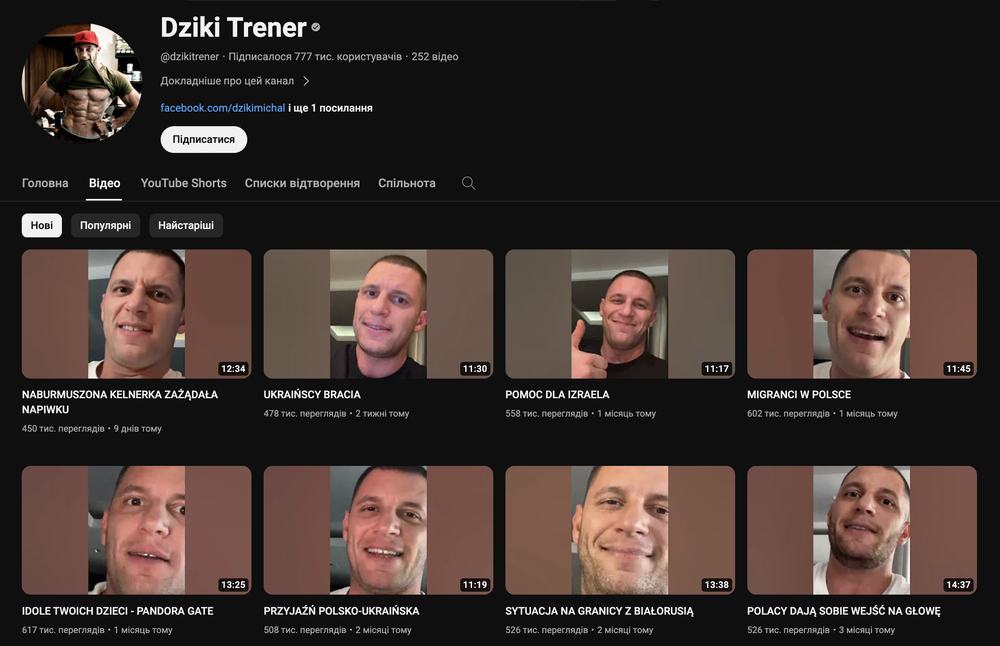
With a "talking head" format addressing hot social issues, 777,000 subscribers, and ranking third in Poland for the number of comments on YouTube, "Dziki Trener" exemplifies the impact of aggressive political blogging.
His content, replete with subscribers, views, and comments, gets further promoted by YouTube itself, suggesting videos like "Poles Are Easily Influenced," "Ukrainian Gratitude," or "Polish-Ukrainian Friendship" to our study participants.
Although the demand for news content in Poland is not as high, informational bloggers still find their niche. Blogging differs significantly from news reporting, often being more emotive, less factual, and sheltered under the guise of personal opinion. The market for expert commentary and the role of the "invited expert" help in promoting these bloggers.
We've previously highlighted how Ukrainian media, including on YouTube, utilize the institute of (pseudo)expertise. Poland also practices engaging in hour-long discussions with "experts," albeit seemingly to a lesser extent. Yet, this format remains influential and potentially hazardous in shaping public opinion.
Take Wojciech Cejrowski, a Polish journalist and satirist, for instance. Once known as a traveler, he now uses his persona, complete with a signature Hawaiian style and a toucan avatar, to maintain recognition and successfully promote his videos on a YouTube channel with 630,000 subscribers.
"However, the majority of his videos have long since shifted focus from travel to NATO and geopolitics. His statements and quotations have earned him a reputation as a far-right figure and several mentions in the 'Brown Book' (a project of the 'Never Again' Association, which compiles all incidents of racism, xenophobia, and discrimination in Poland)."
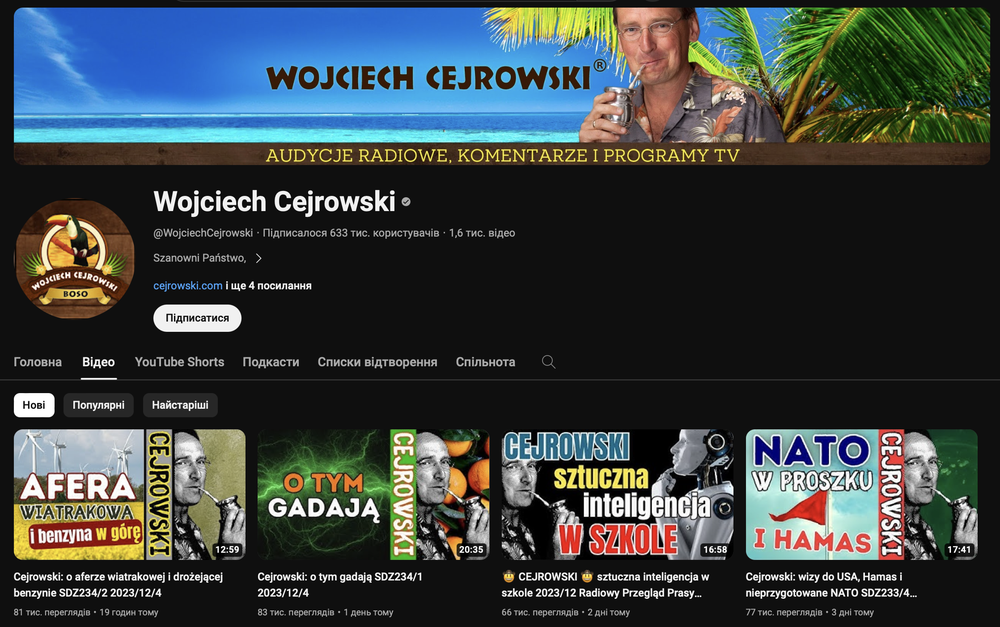
"NATO, HAMAS, rising gasoline prices, and artificial intelligence in schools — these are the typical topics for a successful travel blogger clad in a Hawaiian shirt."
Cejrowski's videos have sometimes justified Putin's decision to start the war, blaming Poland and Western countries. Before the full-scale invasion, he propagated views like "Putin's goal is Ukraine, but Biden's goal is war." On radio broadcasts, he commented on the presence of 100,000 Ukrainians in Warsaw: "If there is even one unemployed person in Warsaw, it means there are too many Ukrainians." Some of his remarks have been picked up by Russian media under headlines like "Poland Acknowledges NATO is a Fiction" or "Poland Assesses the Military Potential of Russia and Ukraine."
YouTube continues to promote Cejrowski's videos, recommending them 280 times to our participants alone, classifying them under "News and Politics," "Blogs," and "Education."
Interestingly, YouTube categorizes "Dziki Trener" as "Daily vlogs." Videos from another pro-Russian blogger and geopolitical expert, Leszek Sykulski, also recommended to our participants, fall under the "Education" category.
This raises a critical question: How does YouTube even recognize or distinguish informational bloggers and experts?
Separating Political Bloggers from Quality Media
The rise of the "talking head" format, combined with charisma (and thus perceived authority) and viewers' "reluctance to watch news," can have serious consequences. Info-bloggers have carved their niche for years, but the lack of a specific category for them often leads to incorrect platform categorization.
Consider, for instance, a video from another blogger, now a military analyst, with a telling title: “Ukraine-plaintiff thinks it's the savior of the world and Europe!!! [Zero gratitude for military equipment].” This video, oddly classified as “Howto & Style,” was recommended 25 times to our study participants by YouTube.
Another example is a video discussing theories about the Smolensk air disaster. Appearing 34 times in recommendations, it was categorized as “Science & Technology” by YouTube.
The extent to which incorrectly assigned video categories influence the likelihood of being recommended to an “incorrect” audience remains an open question. However, the dominance of info-bloggers and sheer clickbait in the “News and Politics” category is becoming an unfortunate reality on YouTube.
Quality media often face a choice between popularity and adhering to ethical and journalistic standards. YouTube has created an environment where media compete not only among themselves but also with entertainment content and information garbage bins, which are not restricted by journalistic standards and at best, do not produce outright fakes.
Quality journalism on YouTube competes with:

Although there's no shortage of falsehoods and manipulations. Often, on a single channel, one might encounter a blend of news, geopolitics, and history — all presented by 'experts,' dressed up with clickbait titles and vivid collages.
Dislike Ukraine? Here's a similar video selection!
YouTube's algorithm creates an "information funnel" once a few similar videos are watched, as seen with one of our participants, recommending videos like “The Unpopular Truth About the Russian-Ukrainian War.
Robert Cheda and Jan Piński,” or the channel “Wiadomości-Polska,” which often manipulatively covers foreign policy topics and broadcasts fakes (for instance, about discussions in Ukraine to introduce the death penalty for traitors).
The study of the extent of hate speech against Ukrainians in Polish social networks is startling. From November 1, 2022, to March 31, 2023, the Media Monitoring Institute and the “Demagogue” Association recorded nearly 300,000 publications and comments against Ukraine and Ukrainians in Poland. That's an average of 84 pieces of content per hour. Although this study focused on Twitter and Facebook, it's easy to imagine how these narratives and content creators migrate to YouTube's video format.
The images show several examples of how YouTube successfully identifies interest in anti-Ukrainian videos and suggests similar content.
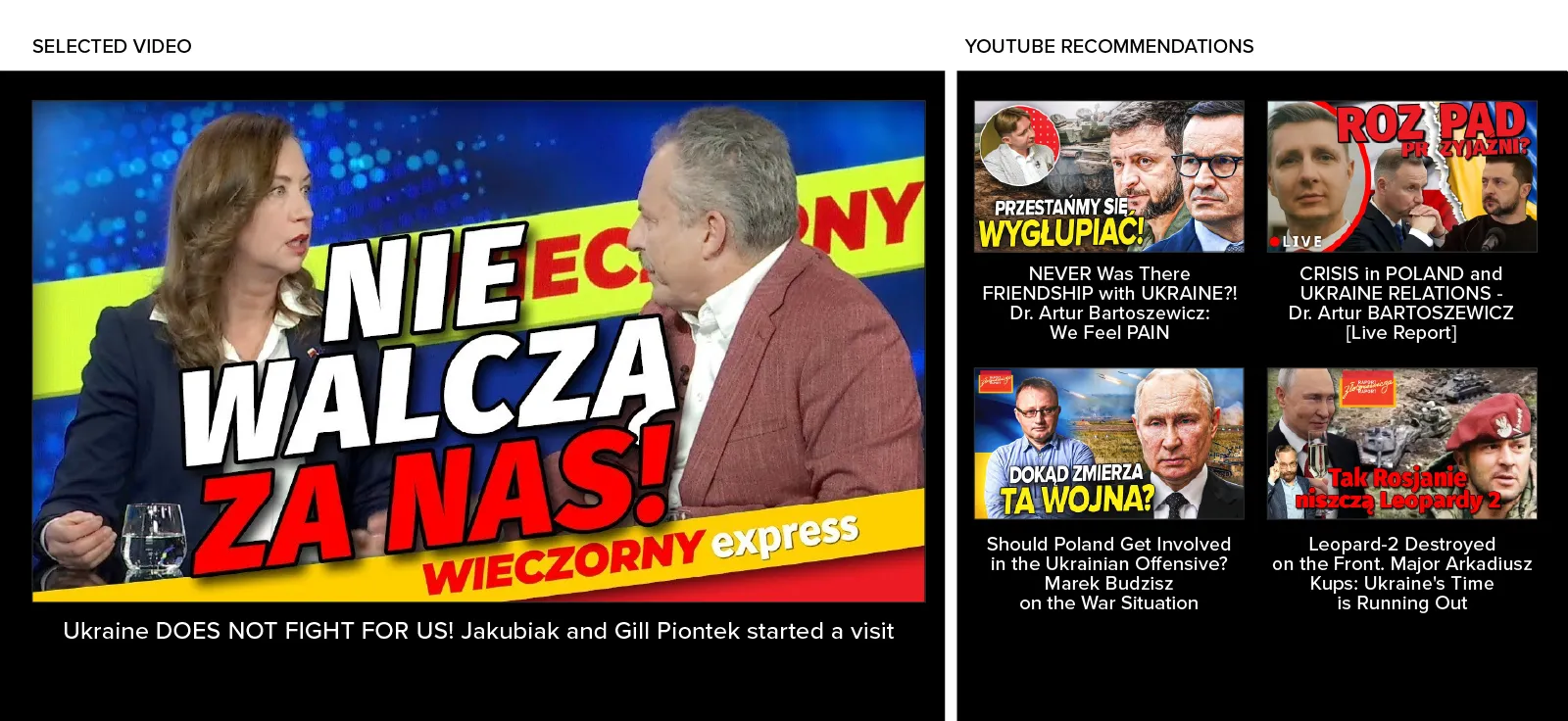
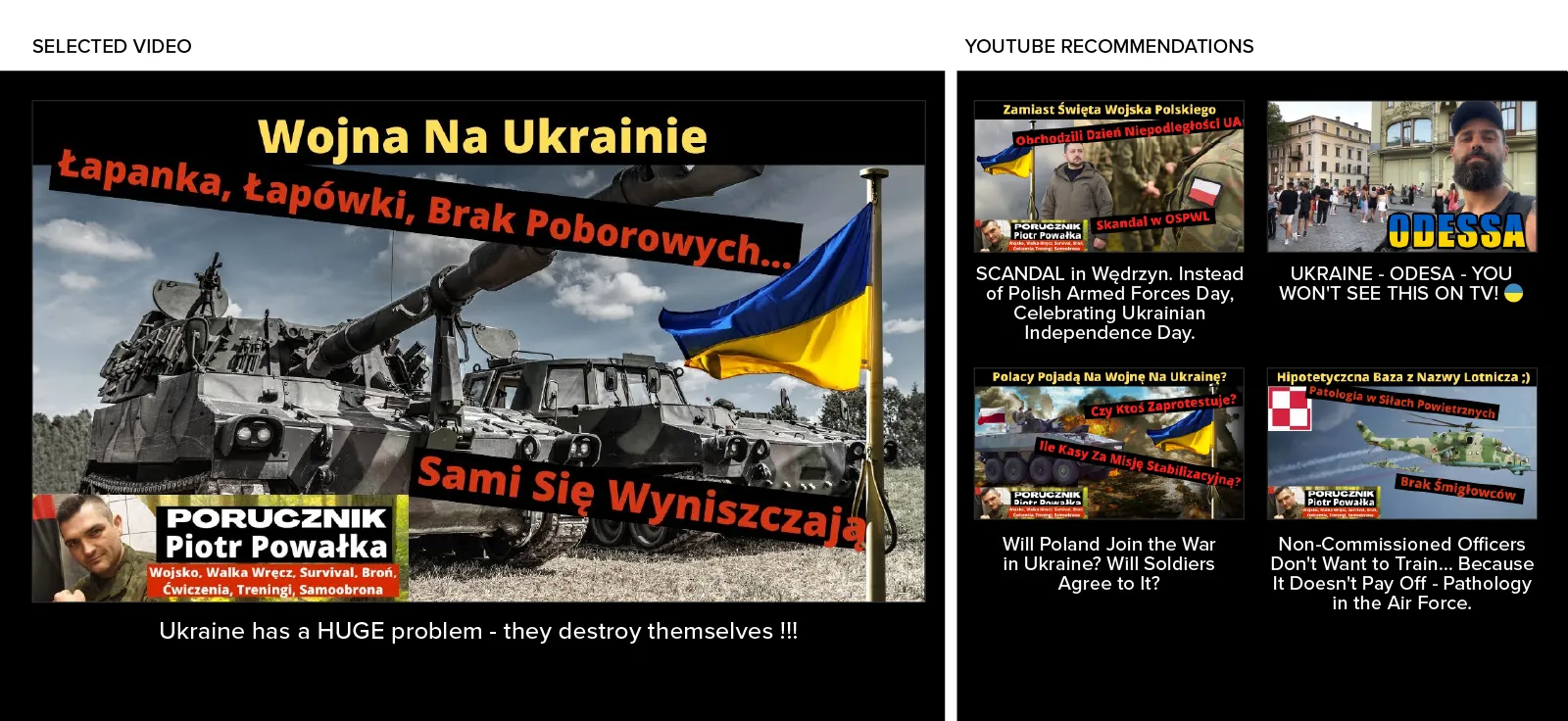
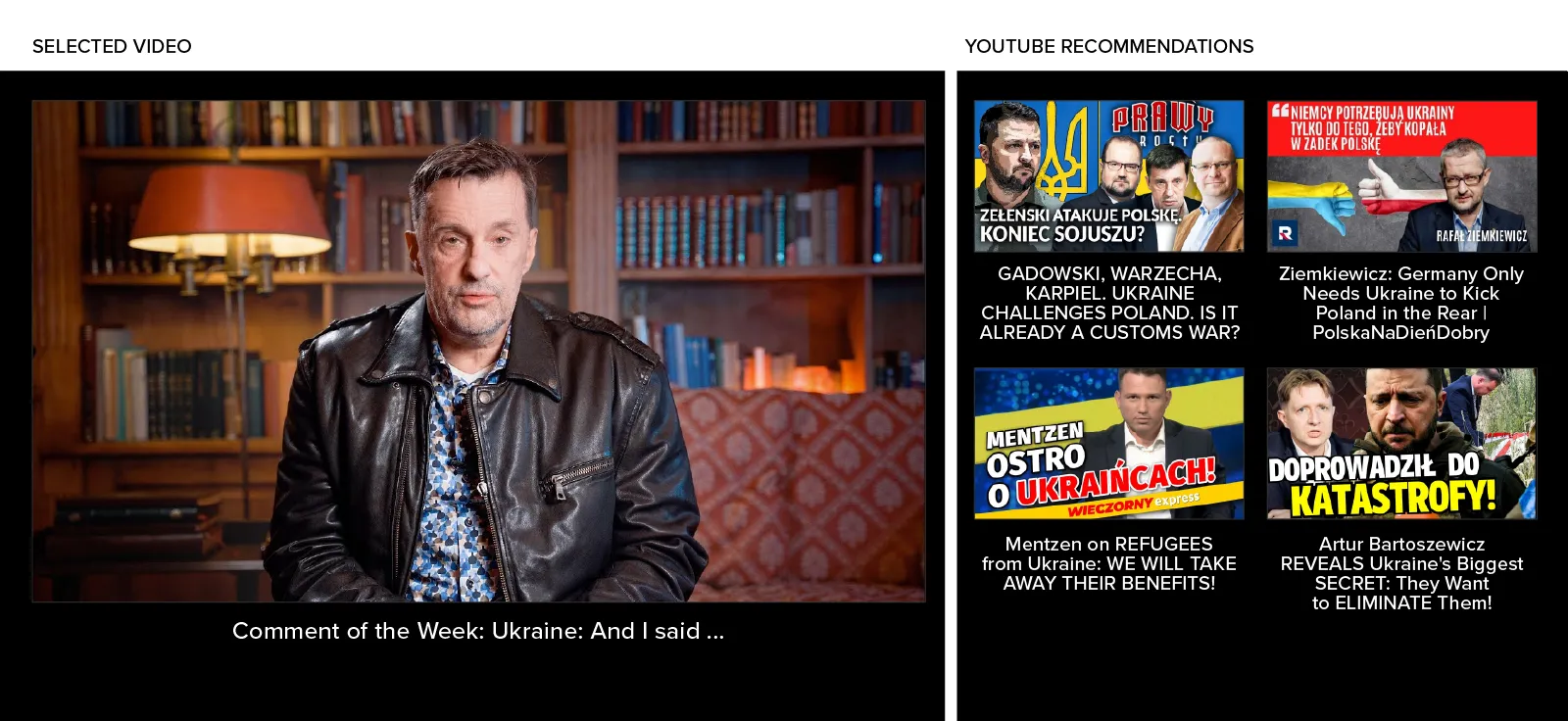



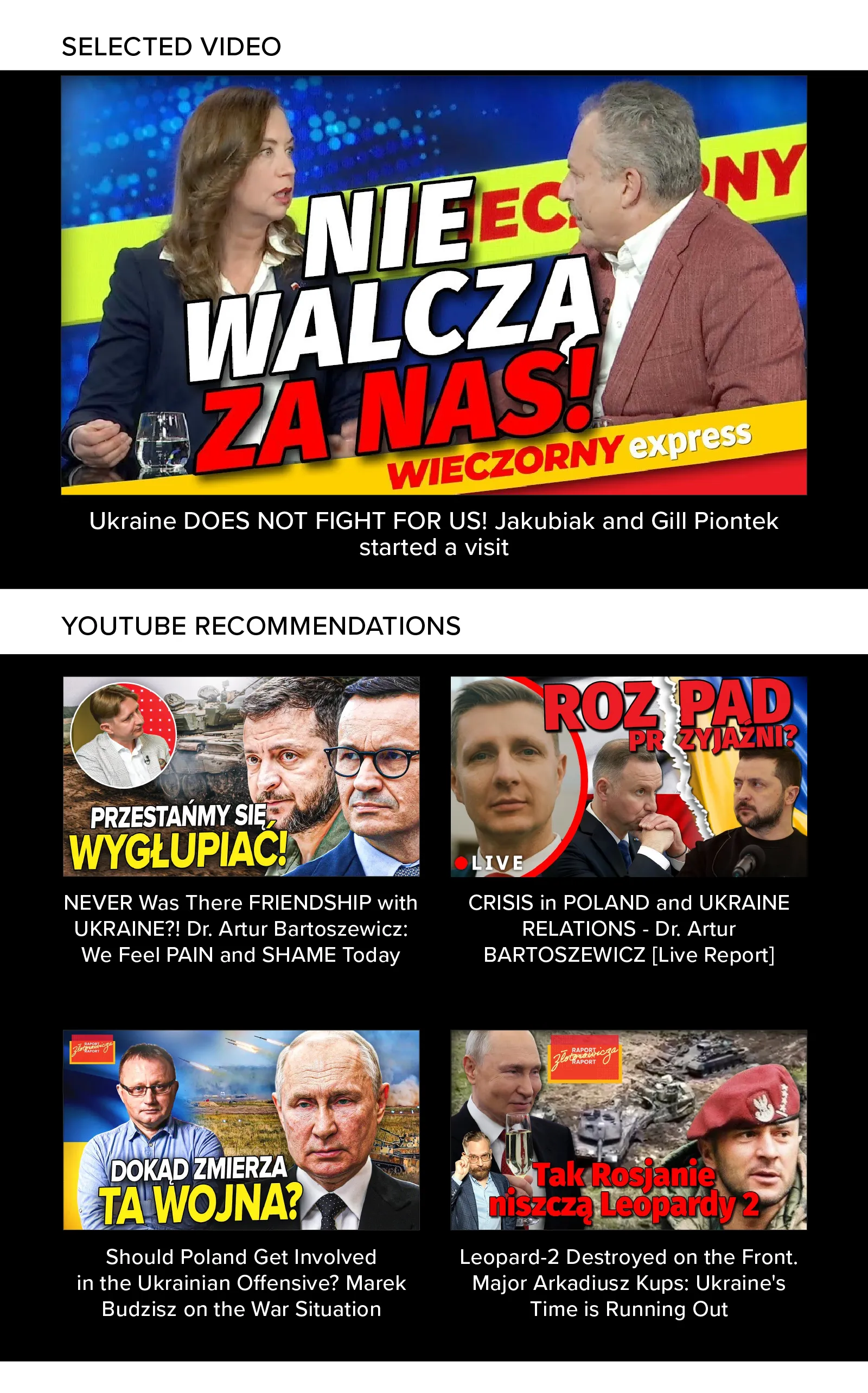


The Success Story: The EU's Fight Against Disinformation on YouTube
Despite the presence of an anti-Ukrainian narrative bubble, there are three key factors in the successful combat against Russian disinformation on YouTube in the EU.
Firstly, Polish YouTube users are significantly more shielded from Russian disinformation than Ukrainians, largely because they do not consume content in Russian.
Secondly, YouTube responds to complaints from civic organizations fighting against hate speech and calls for violence.
"A case in point is the ultranationalist channel 'National Media' ('Media Narodowe') by Polish nationalist Robert Bonkiewicz, which has repeatedly disseminated Russian propaganda narratives and broadcasted hate speech against Ukrainians and Jews. Remarkably, this channel has even managed to receive state subsidies, a fact noted by the 'Never Again' Association mentioned earlier."
As of December, despite continuing to produce content, this YouTube channel had only 420 subscribers and 320 videos.
Another key disseminator of Russian narratives is Sejm deputy Grzegorz Braun from the “Konfederacja Korony Polskiej” (Confederation of the Polish Crown), known for its anti-Ukrainian stance and promotion of the anti-Ukrainian movement “Ukrainization of Poland.” During our study, references to “Konfederacja” were not recommended by YouTube’s algorithms, indicating that the platform may not be promoting this channel's content.
Thus, there is hope that although this channel remains active, the platform does not promote its content through its recommendation algorithms.
In 2022, YouTube blocked the channel “wRealu24” and its creator Marcin Rola. In response, Rola launched BanBye, a video social network intended as a “YouTube killer,” freeing Polish “activists” from supposedly unjust and unfair moderation policies.
Currently, BanBye serves as an alternative Polish YouTube, frequented by ultranationalists.
The third (and potentially most serious) level of protection against disinformation is the EU’s moderation policies on YouTube.
In addition to YouTube's existing moderation policies, the EU's Digital Services Act came into force in late August 2023. This law aims to combat illegal content and create stronger public oversight mechanisms for online platforms.
It requires large platforms and search engines to strictly monitor posted content, immediately remove illegal material, and eliminate targeted advertising based on sexual orientation, religion, ethnicity, or political beliefs. While the law doesn’t specify which content should be moderated, it demands that platforms simplify the user complaint mechanism, respond more effectively, and make the moderation process more transparent, including notifying the content creator of the reasons for blocking.
The law also mandates greater transparency in the functioning of platforms' algorithms and informs users why certain content is recommended, with the option to completely opt out of personalized content.
It's doubtful that YouTube will reveal parts of its recommendation algorithm’s source code, as Twitter once did. However, the fact remains that the EU’s moderation policies are one of the most effective methods of pressuring social platforms. It's unfortunate that these results are not yet extended to Ukraine.

